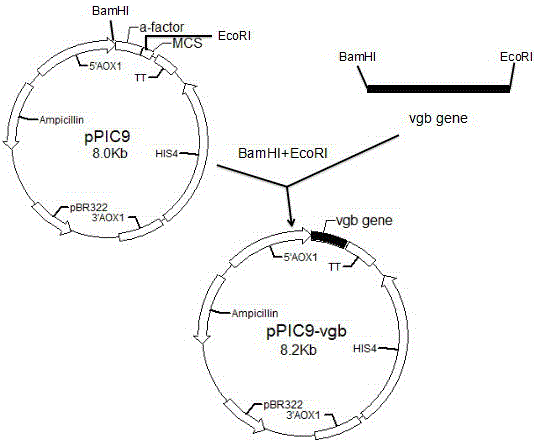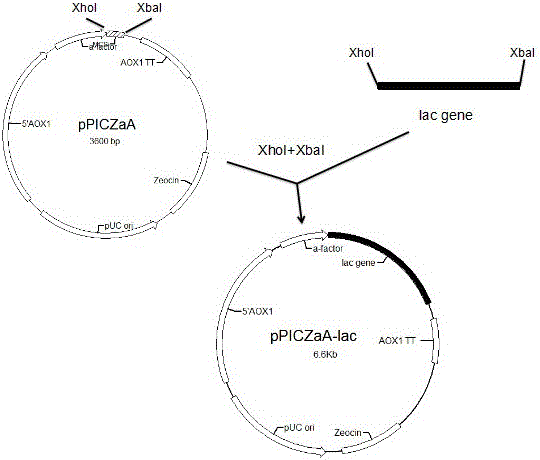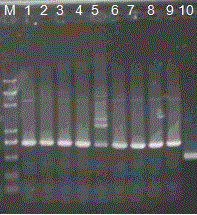Dysoxia-resistant lactase yeast strain and construction method thereof
A technology of yeast strain and lactase, which is applied in the biological field, can solve problems such as the lack of reports on lactase strains, and achieve the effects of increasing yield, improving utilization rate, and promoting growth
- Summary
- Abstract
- Description
- Claims
- Application Information
AI Technical Summary
Problems solved by technology
Method used
Image
Examples
Embodiment 1
[0026] Example 1 Construction of anaerobic-tolerant lactase strains
[0027] 1) Construction of pPIC9-vgb recombinant vector and yeast transformation
[0028] According to the published vgb sequence, design upstream amplification primer vgb-up: 5'-CGGGATCCAAACGATGTTAGACCAGCAAACCAT-3' and downstream amplification primer vgb-do: 5'-CGGAATTCTTATTCAACCGCTTGAGC-3', respectively containing BamHI and EcoRI restriction enzymes For the recognition site, use the recombinant plasmid pSET152-vgb containing the vgb gene sequence in the laboratory as a template, and amplify the vgb gene sequence according to the following system: 10*PCR buffer with Mg 2+5µl, 10mM dNTP mix 1µl, pSET152-vgb template 0.5µl, 50mM vgb-up primer 1µl, 50mM vgb-do primer 1µl, PFUDNA Polymerase 0.5µl, dd water 41µl, the total volume is 50µl. The PCR reaction conditions were: denaturation at 94°C for 30s, annealing at 58°C for 30s, extension at 72°C for 40s, 30 cycles, and extension at 72°C for 10 minutes.
[0029]...
Embodiment 2
[0037] Embodiment 2 Determination of the hypoxia tolerance of shake flask level engineering strains
[0038] The engineering strain GS115-vgb-lac was compared with the lactase-lactase recombinant yeast strain GS115-lac without vgb constructed in the laboratory to compare the hypoxia tolerance at the shake flask level. Two groups of shake flasks were set up for the two kinds of bacteria, one group was the normal control group, which was sealed with 6 layers of gauze; the other group was the hypoxia group, which was sealed with PARAFILM film. The expression process is as follows: Streak the recombinant bacteria stored at -80°C on the YPD plate, culture it upside down at 30°C for 2 days, pick a single colony and culture it in 10 ml BMGY medium at 30°C, 300 rpm to OD 600 =2-6, centrifuge, collect the bacteria, insert into 20ml BMMY medium, induce expression at 30°C, 300 rpm, add methanol to the initial concentration every 24 hours. After 96 hours of induction, the cells were remo...
Embodiment 3
[0039] Example 3 Determination of Lactase Activity
[0040] 1) Standard curve drawing
[0041] Prepare 0.2M NaAc-HAc buffer pH5.2, 0.2M NaAc-HAc buffer pH5.2, 40umol / ml o-nitrophenyl β-D-galactoside (o-NPG), and 5% Na 2 CO 3 solution, fill the tubes as indicated in the table below.
[0042] .
[0043] Make 3 parallel tubes for each gradient, draw the standard curve with o-NP content (umol) as the abscissa and A420 as the ordinate.
[0044] 2) Enzyme activity assay
[0045] Sample tube: Substrate preheated for 5 minutes; 50ul appropriately diluted enzyme solution + 450ul preheated substrate, reacted at 60°C for 10 minutes; immediately added 500ul 5% Na2CO3 to stop the reaction and develop color; add 2ml of experimental buffer to a final volume of 3ml; measure A420 .
[0046] Control tube: No enzyme solution is added during the reaction, just add enzyme solution before measuring the absorbance.
[0047] Enzyme activity unit definition: at 60°C and pH 5.2, the hydrolysis...
PUM
 Login to View More
Login to View More Abstract
Description
Claims
Application Information
 Login to View More
Login to View More - R&D
- Intellectual Property
- Life Sciences
- Materials
- Tech Scout
- Unparalleled Data Quality
- Higher Quality Content
- 60% Fewer Hallucinations
Browse by: Latest US Patents, China's latest patents, Technical Efficacy Thesaurus, Application Domain, Technology Topic, Popular Technical Reports.
© 2025 PatSnap. All rights reserved.Legal|Privacy policy|Modern Slavery Act Transparency Statement|Sitemap|About US| Contact US: help@patsnap.com



